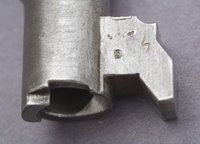Since the days of the Sixteenth Century caracole, the pistol has been the traditional sidearm of the mounted soldier, and pistols designed as such are frequently easy to tell from their "badge-of-rank" kin. As far back as the days of the percussion revolver, the Colt Navy had a .36" bore, while the Colt Army, a cavalryman's weapon and expected to be able to kill a horse, was a .44.
Poland's cavalry had long been emulated in Europe, and as the newly-reconstituted nation built up an army after WWI, they searched for a domestically produced sidearm to equip their cavalry troopers. In 1935 a design by Wilniewczyc and Skrzypinski was settled on and, dubbed the ViS wz.35, was adopted by the Army that year. It was made at the Radom plant with the assistance of Fabrique National engineers working under contract, and offered an interesting blend of familiar Colt/Browning features with some new touches.

LEFT: Radom disassembled, showing its Browning heritage.
Photo by Oleg Volk
Photo by Oleg Volk
The trigger was a sliding affair, similar to that used on many Browning designs, and the grip safety would be familiar to any user of Colt pistols. The gun was a short-recoil-operated, tilting barrel 9mm, with a single column magazine. It had a butt slotted to accept a shoulder stock, and was provided with a decocker so that the trooper could more safely return it to his holster with one hand than if he was trying to control the fall of the hammer with his thumb while astride a possibly skittish mount.

RIGHT: "S"-rune on barrel lug, indicating contract manufacture for Waffen SS, most likely by inmates at Mauthausen.
Photo by Oleg Volk.
After Poland was overrun by the German and Soviet invasion of 1939, the Radom plant fell in the German -occupied half of the country and the Poles were soon forced to churn out arms for their conquerors. The wz.35 was a common issue weapon to the Waffen SS, and as that force grew, the pistol was simplified in manufacture so as to keep up with demand. Polished bluing was replaced by a brushed finish that got rougher as the war went on; the slot for the shoulder stock disappeared; finally the frame-mounted takedown catch was deleted. Late-war guns produced by Steyr using slave labor are wretched indeed, with extremely coarse finishes and crude wooden slabs for grips.
In 1945 the Radom plant was destroyed by the invading Russians; it was a sad ending for the last horse pistol.


3 comments:
Bring on the heat!
Have you shot that pistol and if so, how is it?
Dang if that thing doesn't look sorta familiar! :)
My father told of trying to train Reservists how to ride horses, sometime in the 1930s at Camp Mabry, Austin, Texas. His description of it could be called a rodeo of ineptitude. Up on one side, down on the other. Rider go one way, horse go another. "Fire drill" just ain't in it.
He apparently should have had a bit more time to break the horses before the Brass said, "Saddle up."
Green-broke horses and city boys make for an interesting mix.
Art
Post a Comment